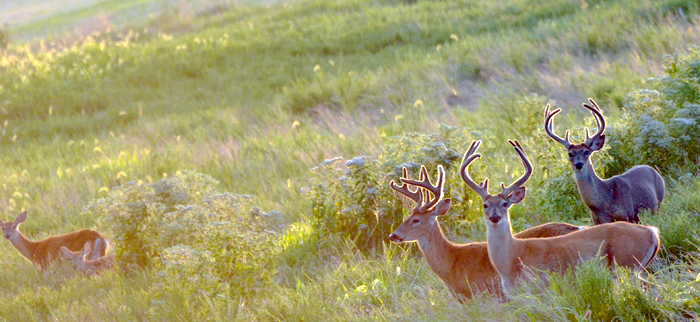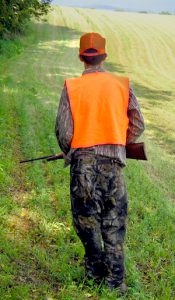White-tailed Deer: Management across diverse landscapes

Deer in field; photo by Matthew Doged
Much has happened with deer management in Maryland during the nearly 20 years since White-tailed Deer, Another Perspective first appeared in the Natural Resource magazine. At the time the article was written, deer were rapidly increasing in number and the problems associated with overpopulation were escalating.
The first edition of the 10-Year Deer Management Plan was adopted in 1998, establishing the framework for how the Department of Natural Resources would approach the task in a state as diverse as Maryland. One step was the significant liberalization of the hunting seasons and bag limits, particularly for females, since they influence population numbers the greatest. This effectively stalled growth in the early 2000s, and numbers declined by 30 percent thereafter.
Today, the herd remains relatively healthy and varies from being at or near desired levels in some rural areas to continuing to be too high in other parts of the state.
 Achieving a sustainable population has not been easy, and reducing it to a level that eliminates conflicts with both the environment and the public continues to be a challenge in areas where populations are still too high.
Achieving a sustainable population has not been easy, and reducing it to a level that eliminates conflicts with both the environment and the public continues to be a challenge in areas where populations are still too high.
White-tailed deer especially have demonstrated they are very adaptable animals. They thrive in varying urban, suburban and agricultural landscapes. In fact, such areas provide more favorable habitat than the aging forests found in the western part of the state. Many sportsmen who once traveled to Garrett or Allegany counties to hunt now remain closer to home, where deer populations are often higher.
Dwindling hunters
Fewer hunters in the woods and limited access to land give deer a competitive edge. Hunting remains the most effective management tool, and no other method exists that can remove 80,000-100,000 deer from the Maryland landscape annually.
Unfortunately, there are approximately half as many deer hunters now as when they peaked in the late 1980s. While the number of licenses has been relatively stable over the past decade, the level is at a minimum for effective management. Additionally, most hunters do not harvest nearly as many deer as the bag limits allow, mainly because there are far more deer than they can make use of, and other interests and daily responsibilities take away from hunting.
Department staff conducts extensive education and outreach programs designed to recruit new hunters and retain existing ones. A series of beginner classes take place across the state, and the Becoming an Outdoors Woman program offers deer hunting as one of their workshops.
No trespassing
Gaining access to lands that hold deer is even more critical and often more problematic. Suburban growth combined with restrictive management has created abundant refuge areas for deer where few controls on the population exist. These areas provide a constant supply of deer.
 The department employs a full time biologist whose primary duties are to work with these communities on how to best manage the species, which often includes trying to identify refuge areas and opening them to some form of limited hunting.
The department employs a full time biologist whose primary duties are to work with these communities on how to best manage the species, which often includes trying to identify refuge areas and opening them to some form of limited hunting.
Unfortunately, current hunts, particularly on private lands, do not reach a great enough intensity to effectively control deer numbers in all areas. Many could use more hunters on more days, willing to take more deer.
Regarding hunts on public lands controlled by the state, efforts include further extending seasons, increasing bag limits and promoting public access. Likewise, counties such as Anne Arundel, Howard and Montgomery have made great strides in developing successful management programs on the public properties they own.
Opportunities
Providing additional hunting opportunities, primarily in the form of Sunday hunting and the use of crossbows, has also proven effective at aiding with population control. Many hunters only have the weekends to hunt, and affording them the opportunity on select Sundays essentially doubles their opportunity.
Likewise, crossbows entice new hunters into the archery season and revive archery hunting for those aging hunters no longer able to use a vertical bow.
 Nonlethal management
Nonlethal management
While the department relies heavily on lethal management techniques to control deer numbers, nonlethal measures are occasionally recommended when hunting is not an option. In some instances, fencing of smaller areas can be effective, as can be audio or chemical deterrents. Nonlethal options are most effective on small scales, and can require significant effort and resources. In most cases, they also do not fully solve the problem, but instead drive deer to another location.
The department continues to support extensive research on deer contraception and sterilization, in both tightly controlled and real-world situations. It is likely that these techniques will be most useful on smaller scales, perhaps when combined with lethal management. The goal remains to find ways to address the population in more developed landscapes.
Turning the corner
The past 20 years have seen an aggressive approach to managing deer in Maryland, and while they are still very abundant in many areas, there are encouraging signs of progress.
The annual deer harvest has slowed significantly in recent years, and survey data suggest hunters are expending more effort to harvest the same number of animals. Both indicate the population has been measurably reduced.
The department will continue to manage deer closely and modify its approach as needed. While we are not out of the woods yet, the next 20 years should continue to tell a story of successful management.
Article by Brian Eyler—deer project leader.
Appears in Vol. 20, No. 1 of the Maryland Natural Resource magazine, winter 2017.


 1-888-373-7888
1-888-373-7888 233733
233733